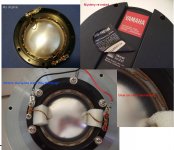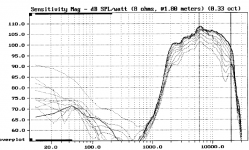Also, afaik Meyer does NOT have any diaphragms built like the original ones, the ones they will supply, afaik, are "standard" design.
_-_-bear
_-_-bear
I think it was done so that it would fit the standard 1.4" throat?
The design of the driver itself is a separate matter??
Do not all the "alnico" drivers also have an expansion between the phase plug and exit??
_-_-bear
I wish they would have used the standard 1.4".
My SteroLab Tractrix are just a hair to big at the throat.
Yes the alnico driver have an expansion between the phase plug and exit.
The alnico magnet is/was usually in the shape of a tube
and so the exit had to go through the middle of it.
The ideal situation for such a driver would be, if the extension had
already the desired horn contour i.e. Tractrix, LeCleach ect.
It would really look cool, if this extension was of nice wood and the back
cover out of the same wood.
Last edited:
Also, afaik Meyer does NOT have any diaphragms built like the original ones, the ones they will supply, afaik, are "standard" design.
_-_-bear
Meyer was using the original diaphragms but they limited the excursion by
applying epoxy or the likes to the surround fingers. This had a bit of a negative effect on the sound.
Look at the pic:
Attachments
Radian, I've been inside a reasonably large number of these drivers. What I have seen is the foam blocks, foam all the way around (iirc), damping stuff painted on part or all of the diaphragm, but never anything at all on the the fingers.
I'm not sure of the point of the foam blocks...
As far as wood on the rear, too resonant for me. I would prefer something very very dead and solid.
_-_-bear
I'm not sure of the point of the foam blocks...
As far as wood on the rear, too resonant for me. I would prefer something very very dead and solid.
_-_-bear
Radian, I've been inside a reasonably large number of these drivers. What I have seen is the foam blocks, foam all the way around (iirc), damping stuff painted on part or all of the diaphragm, but never anything at all on the the fingers.
I'm not sure of the point of the foam blocks...
As far as wood on the rear, too resonant for me. I would prefer something very very dead and solid.
_-_-bear
Strange that you never came across one that had the glue on the surround.
The pic clearly shows some sort of epoxy material on the outer part of the
surrounds. Maybe Meyer tried different methods to make the driver more
PA reliable.
There have been lots of JA6681 drivers selling in the past that where
damaged. Although a very smart design, the beryllium copper fingers do not
only have advantages. The brittleness of that material mix was the cause
of many failures in low coupled hard driven PA applications. There was one
guy over at Audio Asylum who said he had six damaged JA6681 laying around
and did not find any diaphragms for them anymore.
The risky thing when purchasing JA 6681 drivers is that the seller can say
the drivers measure ~16 Ohm but they are physically useless because the
surrounds are damaged. This happened to me.
One of my drivers had seven fingers broken but it was electrically okay.
The foam blocks in the Meyer 1401A do certainly limit the excursion
and therefore protect the diaphragms from physical damage.
The foam blocks also raise FS and Q of the driver. Could be that Meyer
was using this approach to causes a stronger output in the lower region where the conical round horns that Meyer used are weaker than most
conventional horns.
Klaus
Anyone knows if the Altec 2.8" diaphragms will fit into the yamahas ?
I am of the impression that they will, but will NOT function the same way - the sound will likely suck, imo.
_-_-bear
Radian, I can't tell for sure from the pix, but it looks like more of the PVA dope that I have found spread on the diaphragm itself in various amounts...
I would be interested in any and all dead/blown diaphragm assemblies out there, for experimentation and dissection purposes...
_-_-bear
I would be interested in any and all dead/blown diaphragm assemblies out there, for experimentation and dissection purposes...
_-_-bear
Anyone knows if the Altec 2.8" diaphragms will fit into the yamahas ?
Hi Lagroute,
The JA6681b has a 66mm diaphragm as the the first two digits indicate.
If the Altec has the same diameter, than it would be worth a try.
But the shape of the dome has to be absolutely perfect also.
Hi Radian, how do you cross your Fane ST tweeters to yamaha's ? You commented that they can sound aggressive if used not properly...
I just got a pair and would like to make crossovers for them, do you mind sharing your design?
I have a pair of yamaha 6681b with 16ohm phenolic diaphragms.
thanks!
I just got a pair and would like to make crossovers for them, do you mind sharing your design?
I have a pair of yamaha 6681b with 16ohm phenolic diaphragms.
thanks!
Hi traskutis,
the Fane ST5022 has a falling response from 7k at 111 db to about 14k at 107 db.
If you cross it over with just a cap of 2uf for the 8 Ohm version or 1uf for the 16ohm version
it will be 107 db flat to about 14k and slowly fall off to 105db at 18k. Use good cap with a 2.2-10nf
silver mica bypass. This really gets the Fane singing.
There have been some variations in the ST50xx over the years of production, so just
play a bit with values if you think it sounds not transparent enough.
the Fane ST5022 has a falling response from 7k at 111 db to about 14k at 107 db.
If you cross it over with just a cap of 2uf for the 8 Ohm version or 1uf for the 16ohm version
it will be 107 db flat to about 14k and slowly fall off to 105db at 18k. Use good cap with a 2.2-10nf
silver mica bypass. This really gets the Fane singing.
There have been some variations in the ST50xx over the years of production, so just
play a bit with values if you think it sounds not transparent enough.
Last edited:
Will try that, mine is ST5020.
cheers
In this case I would play with values between 1.5uf and 2uf and
don't forget the silver mica, it makes all the difference. I tried some
russian 2200pf and that did the trick.
Here is a plot of your ST5020 which I got also:
Attachments
You should buy my 5022s then. One needs a diaphragm and the wife said to get rid of the stuff I'm not using. I posted them for sale here, but need to revise the price to a much lower one.
Will try that, mine is ST5020.
cheers
I made some measurement of JA 4205,
Will try to make more in one week
Will try to make more in one week
An externally hosted image should be here but it was not working when we last tested it.
I made some measurement of JA 4205,
Will try to make more in one week
An externally hosted image should be here but it was not working when we last tested it.
Does not look bad at all.
here is a pair available :
PAIR Yamaha JA-6681B Horn Compression Drivers TAD - eBay (item 200470792205 end time May-12-10 15:44:45 PDT)
PAIR Yamaha JA-6681B Horn Compression Drivers TAD - eBay (item 200470792205 end time May-12-10 15:44:45 PDT)
- Home
- Loudspeakers
- Multi-Way
- Info on the Yamaha JA-6681 compression driver

